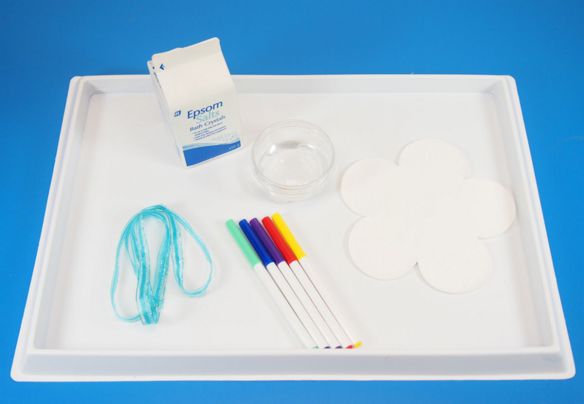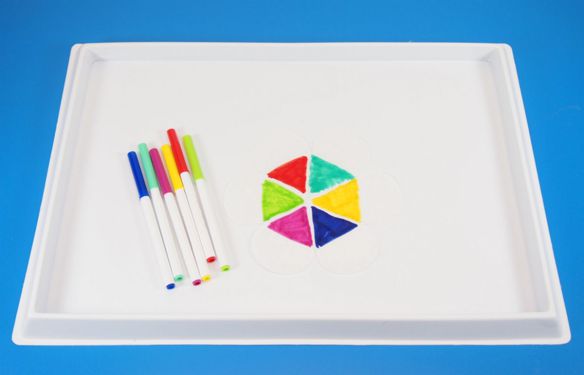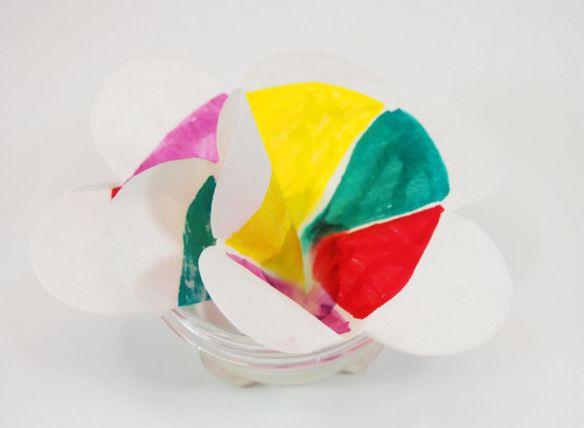Find out what colors of ink are used in your markers! Chromatography is used to break a solution into its component parts. In other words, the colors of markers are often made by combining several other colors together. To split these colors back apart, we need to use chromatography! In this post, we’ll show you how this amazing technique can be used to decorate our Color Diffusing Flowers with crazy effects!
Age: 5+
Duration: 10 minutes (+15 minute drying time)
Learning Objectives: Learn about the properties of colors through chromatography. Learn what chromatography is and how certain effects are produced using simple materials. Develop a basic understanding of the science behind color mixing. Explore fundamental scientific concepts, such as physical (compared to chemical) changes in mixtures.
You’ll Need:
• R2440 Color Diffusing Paper Flowers
• Epsom Salts
• Plastic cup
• Warm water
• Markers (washable brands)
Optional:
• Ribbon
• Scissors
Chromatography is a great method to introduce young kids to science… or even to try out for yourself! Basically, the materials used in chromatography help to split a mixture back into its original parts. The Epsom Salts in water attach onto certain molecules in the ink and push them apart. Therefore, it’s a great means of exploring color mixing and how colors are put together to make new ones.
We made a very similar experiment in one of our YouTube videos. Check it out at the link!
 Let’s start with our materials! As you can see, we’ll need to select a type of flower, some markers and get our basic chromatography equipment ready. Because markers are made with various shades, you won’t have to worry about staying away from primary colors.
Let’s start with our materials! As you can see, we’ll need to select a type of flower, some markers and get our basic chromatography equipment ready. Because markers are made with various shades, you won’t have to worry about staying away from primary colors.
Note: I’ve included yellow just to add a colorful range to our chromatography flower, but as I’ve found, yellow is the only color that won’t separate as well as the others.
 There are several different types of flowers to choose from. Select your favorite flower type, then count how many petals are on each flower. Choose a similar number of marker colors per petals on each flower, or double up on some colors. Start at the center of the flower and draw a triangle pointing inwards, with the base facing the petal side. Color in the triangle.
There are several different types of flowers to choose from. Select your favorite flower type, then count how many petals are on each flower. Choose a similar number of marker colors per petals on each flower, or double up on some colors. Start at the center of the flower and draw a triangle pointing inwards, with the base facing the petal side. Color in the triangle.
 Mix one teaspoon of Epsom salts in one cup of warm water. This solution is what you will use to start the chromatography process! I used a wide, flatter cup to help with dipping the flower evenly into the solution.
Mix one teaspoon of Epsom salts in one cup of warm water. This solution is what you will use to start the chromatography process! I used a wide, flatter cup to help with dipping the flower evenly into the solution.
Pinch your flower at its center until you form a small handle underneath. This will scrunch the flower a little bit, but it’s important to make this “handle” prominent enough that it will reach the surface of the Epsom salt solution.
 Now dip the handle part at the center of the flower into the Epsom salt solution. See how the petals stick out from the center? The petals will hold the flower in place so it doesn’t collapse into the cup. You can even curl the petals outwards so that they hold the weight of the flower out from the center.
Now dip the handle part at the center of the flower into the Epsom salt solution. See how the petals stick out from the center? The petals will hold the flower in place so it doesn’t collapse into the cup. You can even curl the petals outwards so that they hold the weight of the flower out from the center.
 Look at what happens over time! Not only does the whole flower get completely covered in ink, but the various colors separate into other colors!
Look at what happens over time! Not only does the whole flower get completely covered in ink, but the various colors separate into other colors!
 Here, I’ve tried another type of flower. You can see the gradual changes that take place in a matter of minutes!
Here, I’ve tried another type of flower. You can see the gradual changes that take place in a matter of minutes!
 You can start to see a change in coloration here.
You can start to see a change in coloration here.
 Now, the ink has completely covered the surface of the flower and is separating the ink into individual lines of color. See the small patch of purple near the center of the flower? You can see some light pink being separated from the darker purple parts.
Now, the ink has completely covered the surface of the flower and is separating the ink into individual lines of color. See the small patch of purple near the center of the flower? You can see some light pink being separated from the darker purple parts.
 Ta-da! When the Color Diffusing Flower is fully saturated in water, remove from the cup and set on top of a dry container. Leave to dry for about 15 minutes.
Ta-da! When the Color Diffusing Flower is fully saturated in water, remove from the cup and set on top of a dry container. Leave to dry for about 15 minutes.
 I’ve set out all the dry flowers here for viewing. Look at the separation in colors! You’ll see the most differences coming from colors such as teal, indigo, magenta and orange.
I’ve set out all the dry flowers here for viewing. Look at the separation in colors! You’ll see the most differences coming from colors such as teal, indigo, magenta and orange.
 Here’s a closeup of some separate colors that went into creating this soft blue color!
Here’s a closeup of some separate colors that went into creating this soft blue color!
 Check out this indigo color! You can see tinges of light blue at the bottom, dark blue in the middle and magenta at the top!
Check out this indigo color! You can see tinges of light blue at the bottom, dark blue in the middle and magenta at the top!
A good exercise for kids is to guess which colors might have gone into making certain colors before they use their designs with chromatography.
 To make your designs extra special, combine them into a pretty garland!
To make your designs extra special, combine them into a pretty garland!
 Fold your flower in half, then cut two small slits near the center, at about 2″ apart.
Fold your flower in half, then cut two small slits near the center, at about 2″ apart.
 Unfold your flower. Next, weave one end of a length of ribbon through the first slot and back out through the second slot.
Unfold your flower. Next, weave one end of a length of ribbon through the first slot and back out through the second slot.
 Repeat for the remaining flower shapes!
Repeat for the remaining flower shapes!
 …And hang them up! Combining science with art is lots of fun!
…And hang them up! Combining science with art is lots of fun!
Thanks for checking out this post! Like us on Facebook, Share this post with your friends, or Subscribe to this blog today to receive original craft project updates every Monday, Wednesday and Friday!




